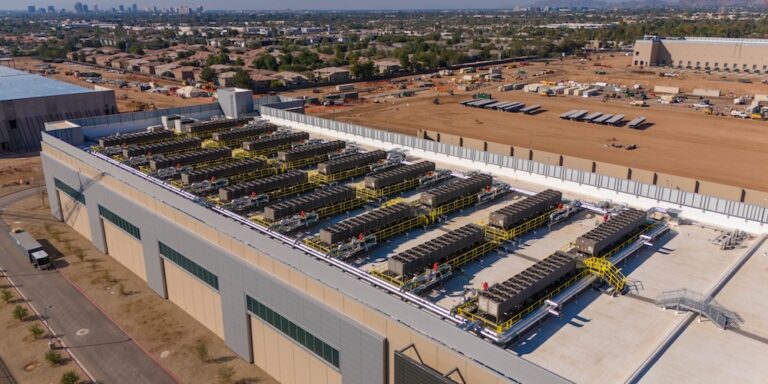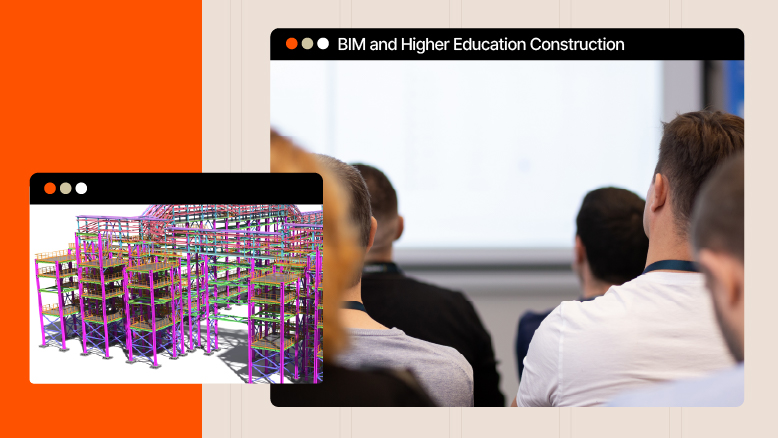— 6 min read
Building for Big Data: An Industry-Wide Challenge to Innovate
Last Updated Mar 12, 2025
Last Updated Mar 12, 2025

The demand for innovative and efficient data centers is skyrocketing. From powering cloud computing and the exponentially growing use of artificial intelligence to supporting the ever-growing Internet of Things (IoT), data center facilities continue to be critical infrastructure for a modern, data-centric society.
Construction companies are facing new challenges and opportunities as they adapt to the rapidly evolving landscape of data center construction. These highly specialized facilities are designed to house sensitive equipment and they demand advanced tools, cutting-edge solutions and precise execution to meet industry standards.
Table of contents
How the Data Boom Is Impacting Construction
The exponential growth of data has significantly influenced the construction industry in recent years. The sheer volume of data generated today demands a new approach to data center design and construction. These facilities must now accommodate massive amounts of information, requiring innovative solutions that address some key challenges that include:
Meeting the Demands of Big Data
Building data centers that are capable of handling the ever-increasing volumes of data generated today presents significant challenges for builders. These facilities must be designed with high levels of redundancy, robust cooling systems and efficient power infrastructure to ensure optimal performance and minimize downtime.
Addressing Environmental Concerns
Due to their high energy consumption, data centers can have a significant environmental impact. Construction companies must prioritize sustainability by integrating renewable energy sources, optimizing cooling systems and reducing their ecological footprint throughout the building process.
Navigating a Complex Regulatory Landscape
Complying with local, state and federal regulations — including zoning ordinances, environmental regulations and data privacy laws (such as GDPR and CCPA) — can be complex and time-consuming.
Managing Skilled Labor
Finding and retaining skilled workers with the expertise to design, build and maintain complex data center infrastructure will continue to be a challenge.
The Evolving Landscape of Data Center Construction
Many challenges related to data center construction are interconnected. Issues like energy consumption and efficient cooling are often intertwined. While rural areas may offer ample space for construction, they may also lack readily available power sources, necessitating solutions like on-site power generation.
The rise of AI further complicates the equation.
The increase in AI-driven data generation will require significantly more data centers, and at a much faster pace. While advancements like DeepSeek’s AI model are making data processing more efficient and reducing energy costs, experts warn that these gains could drive even broader AI adoption. This could ultimately sustain or even increase the demand for data centers, rather than reducing it.
Israel Simmons
Civil & Infrastructure Solutions Specialist
Procore Technologies
The ever-increasing demand for data processing power driven by AI necessitates constant innovation in data center design. However, the rapid pace of innovation in AI hardware can challenge the seamless scalability of data centers. For example, newer chips with higher storage capacity may mean less space is required, but more water for improved cooling could be a trade off.
Sustainability and diverse national, state and regional policies around energy consumption, material use and even site selection can also all play a role in design and construction. Khaula says that successful companies are finding their niches in sustainability, innovating in efficient design, construction and MEP (Mechanical, Electrical, Plumbing) practices.
There are companies that are trying to be more efficient and innovative. The companies that are succeeding are the ones making innovation and efficiency a focus.
Israel Simmons
Civil & Infrastructure Solutions Specialist
Procore Technologies
Data centers are increasingly incorporating renewable energy sources like solar and wind. Some companies are even exploring nuclear power, as exemplified by AWS's 2024 investments in its pursuit of sustainable operations.
Recognizing the need for reliable and carbon-free energy sources to support its growing infrastructure, AWS strategically acquired Talen Energy's data center campus, located adjacent to the Susquehanna Steam Electric Station in Pennsylvania. AWS has also actively supported the development of Small Modular Reactors (SMRs), a promising advancement in nuclear technology that offers the potential for faster construction and lower costs. These strategic investments and partnerships align with AWS's stated commitment to achieving net-zero carbon emissions across its operations by 2040.
Cooling Innovation: A Key Factor
One of the biggest challenges in data center construction is cooling. As data centers continue to grow and manage heavier workloads, conventional air-cooling systems are struggling to keep up. The increasing density of servers produces significant heat, making efficient cooling solutions essential to prevent system failures. Industry experts note that traditional cooling methods are no longer adequate, driving the adoption of more advanced and sustainable technologies.
But there have been some interesting innovations. Microsoft's Project Natick demonstrated a groundbreaking approach to data center cooling by submerging a fully functional data center in the ocean off the coast of Scotland. This solution leveraged the consistent and cool temperatures of the deep sea to naturally cool the servers, eliminating the need for energy-intensive air conditioning systems while prolonging the health and life of the servers.
By utilizing the natural environment for cooling, Project Natick significantly reduced energy consumption and demonstrated the potential for sustainable and environmentally friendly data center operations. While Project Natick was a groundbreaking experiment in data center cooling, it’s just one of many innovative approaches emerging as companies strive to address one of the most pressing challenges in data center design and construction.
Innovative cooling technologies, such as liquid cooling and immersion cooling, are gaining traction because they offer significant advantages over traditional air-cooling by:
Improving Energy Efficiency
Liquid cooling systems can be more energy-efficient than traditional air-cooling systems, reducing the energy consumption of the data center.
Increasing Cooling Capacity
Liquid cooling can effectively dissipate heat from high-density servers, enabling higher levels of computing power within the same space.
Reducing Noise Pollution
Liquid cooling systems can operate more quietly than traditional air-cooling systems.
Stay updated on what’s happening in construction.
Subscribe to Blueprint, Procore’s free construction newsletter, to get content from industry experts delivered straight to your inbox.

The Future of Data Center Construction: A 3-Prong Approach
The future of data center construction will be shaped by emerging technologies, a focus on sustainability and data-driven decision-making.
The next generation of data centers will be shaped by cutting-edge technologies and a commitment to sustainability. Integrating advancements such as AI, robotics and prefabrication will be key to optimizing construction processes and boosting efficiency.
Furthermore, prioritizing sustainability is paramount. Incorporating renewable energy sources like solar and wind power into data center designs is important for reducing the environmental impact. Implementing advanced cooling technologies, such as liquid cooling and free-air cooling, is essential for optimizing energy consumption. Additionally, conserving water resources is vital. Utilizing water-efficient technologies and implementing rainwater harvesting systems can significantly reduce water consumption.
Construction companies will increasingly rely on data analytics to optimize their operations, improve project performance and make more informed decisions throughout the project lifecycle. Project management platforms will play a big role in this process by providing real-time data on project progress, identifying potential risks and issues, facilitating communication and collaboration and optimizing resource allocation.
With the rising demand for data centers, the industry is at a key moment. Construction companies and owners that adopt integrated, end-to-end technologies rather than isolated solutions, prioritize sustainability and leverage data-driven insights will not only overcome emerging challenges but also capitalize on opportunities in this growing market. By constructing smarter, greener and more efficient data centers, they can set new industry benchmarks and spearhead innovation in this ever-evolving landscape.
Was this article helpful?
Thank you for your submission.
100%
0%
You voted that this article was . Was this a mistake? If so, change your vote here.
Scroll less, learn more about construction.
Subscribe to The Blueprint, Procore’s construction newsletter, to get content from industry experts delivered straight to your inbox.
By clicking this button, you agree to our Privacy Notice and Terms of Service.
Categories:
Tags:
Written by
Marlissa Collier
Marlissa Collier is a journalist whose work focuses on the intersections of business, technology, policy and culture. Her work has been featured in digital and print formats with publications such as the Dallas Weekly, XO Necole, NBCU Comcast, the Dallas Nomad, CNBC, Word in Black and Dallas Free Press. Marlissa holds an undergraduate degree in Construction Engineering from California State University, Long Beach and an MBA from Southern Methodist University’s Cox School of Business.
View profileExplore more helpful resources

Preconstruction Partnerships: How Safety Pros Can Collaborate with Estimating & Proposal Teams
Construction leaders and safety professionals are developing a strong understanding of how safety programs positively impact project outcomes. When safety is woven into every aspect of operations from pre-construction to...
Construction Business Development: Tracking and Winning the Right Opportunities
Construction business development isn’t just a response to deadlines: It’s a long-term strategy rooted in focus, visibility and timing. Delays, funding gaps and market pressure have made it harder to...

Qualifications-Based Selection: Prioritizing Expertise over Initial Cost
For large or complex construction projects, owners and public agencies often use qualifications-based selection (QBS) to prioritize experience and capability over merely selecting the lowest bid. QBS involves owners choosing...

Using BIM in Higher Education Construction
As the construction industry changes, higher education institutions have started to implement building information modeling (BIM) at a rapid pace. If architecture, engineering and construction (AEC) companies want to work...